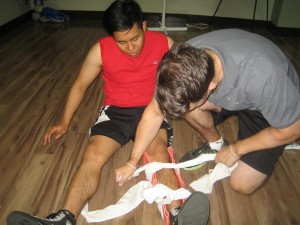
The ankle is not actually a bone, but a joint that has a slightly complicated structure. The ankle joint consists of three bones that articulate together: tibia and fibula of the lower leg and calcaneus of the foot. The tibia, being the main bone of the leg, makes up the inside of the ankle bone whereas the fibula, the smaller bone, makes up the outside of the ankle bone. The malleoli, the distal ends of the tibia and fibula, are bone lumps that can be felt on the inside and outside of the ankle, which form a mortise or an arch. Synovial fluid allows for smooth movement of joint surfaces. The ligaments in the ankle joint keep the bones in place.
Ankle Fractures Causes
When enough stress is added to the ankle, the joint becomes injured and may lead to a broken ankle. Some of the common causes include:
- Jumping from a high level and landing on foot
- Tripping or falling
- Rolling the ankle in or out
- Twisting or rotating the ankle
- Extreme flexing of the joint
Ankle Fractures Symptoms
Ankle fracture symptoms are similar to those of any kind of fractures in the body. They are observable with the naked eye. Some of the fractures include:
- Pain, usually not on the precise location of the fracture
- Swelling and bruising around the joint that usually extends to the toes
- Inability to walk or bear weight on affected ankle
- In severe fractures, bone deformities and bone exposure
Ankle Fractures First Aid
Sometimes, it may be hard to distinguish whether the injury is a
broken bone or simply a sprain or even a dislocation. However, when one is not sure, always assume the worst and give first aid for ankle fractures:
- If there is bleeding, control bleeding by applying firm pressure on the wound using a clean cloth or sterile gauze.
- Elevate the ankle, preferably at a level higher than the rest of the body.
- Apply ice pack or cold compress to the injured area to reduce swelling and pain. This should be done within 12-24 hours after the injury occurred.
- Avoid any ankle movement to avoid complications.
- Take ibuprofen medicine to reduce pain and inflammation, if necessary.
Disclaimer: This article is for information purposes only and not meant to substitute for medical instruction or formal training. To learn how to manage ankle fractures and other fractures in the body, enroll in First AidCourses.
